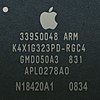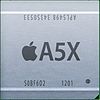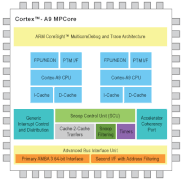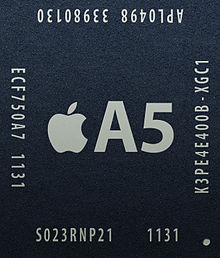Samsung S5L
| Samsung S5L | |
|---|---|
 Samsung S5L8900 |
|
| Production: | since 2006 |
| Producer: | Samsung |
| Processor clock: | 400 MHz to 1,400 MHz |
| FSB cycle: | 103 MHz to 1333 MHz |
| L1 cache size: | 16 KiB |
| Instruction set : | ARM9 / ARM11 / ARMv6 / ARMv7 / ARMv8 |
| Microarchitecture : | ARM , Swift, Cyclone |
Names of the processor cores:
|
|
Samsung S5L is a range of System-on-a-Chips (SoC) manufactured by Samsung primarily for Apple. They combine an ARM - the main processor and possibly PowerVR - GPU , memory and some controllers for z. B. NAND memory and audio on one chip. They were introduced by Apple in 2006 with the 2nd generation iPod nano . They are mainly found in Apple devices such as the iPod , iPhone and iPad . Samsung also uses the design of the S5L series for its own SoCs. S5L SoCs are also known under the names APL and Apple A4 - Apple A7 . PortalPlayer SoCs were used as the predecessor of the S5L87 chips, the Freescale i.MX series, which was used in an iPhone prototype in 2005, can be seen as the predecessor of the S5L89 chips . Successors are the APL1011 SoCs manufactured by TSMC .

history
In 2006, Apple introduced the 2nd generation iPod nano and iPod Classic . The iPhone, internally known as “ Project Purple” , was also in development . Apple needed new SoCs for this planned expansion of the product range, so the S5L87 SoCs were created for the less power-hungry iPod family, and after initial attempts with a Freescale i.MX31 SoC for the first iPhone, the S5L89 SoCs for the more powerful Apple Devices iPhone , iPod touch and iPad . The S5L87 SoCs replaced the PortalPlayer processors previously used in the iPod. Initially, it was not planned that third-party software would run on S5L89 Socs - the graphics processors were accordingly designed to save electricity. This changed with the introduction of the App Store . As a result, Apple bought the chip design company PA Semi in 2008 and developed the almost identical SoCs S5L8922 and S5L8930 from the S5L8920 in order to meet the increased requirements. Since 2010 Apple has been marketing the S5L89 series as the “ Apple A” chip. The first SoC advertised in this way was the S5L8930 under the name Apple A4 . In 2013, Apple introduced the M7 coprocessor for calculating movement data parallel to the A7 chip . However, this is manufactured by NXP Semiconductors and shares only the origin of the sales designation with the “Apple A” series. The S5L87 series is not specifically advertised.
Origin of name
The designation S5L is Apple's internal designation for the SoCs. It appears in the source code of iOS. Since the acquisition of PA Semi, the name on the chips has been APL . In the source code of iOS, however, the chips are still called S5L. Apple's marketing name is Apple A , so the S5L8960 and S5L8965 are both marketed as the Apple A7, even though they are two different SoCs.
labeling
While the first chips were only printed with the number after the S5L (e.g. 8701 for the S5L8701, see picture on the right), after the purchase of PA Semi the name was printed as an anagram of the sequence of digits with the leading letter combination APL - this is how the Type designation S5L8940 with the imprint APL0498 . With the introduction of the S5L8930, the designation APL0398 moved to the edge, while the marketing designation A4 was placed in the center. The first prototypes of the A4 chip did not yet have this lettering.
technology
General
Samsung S5L systems on a chip represent the most important chip in iPods, iPhones and iPads. All of these devices are portablecomputers operatedwith lithium-ion batteries for playing back electronic media and therefore have the central components of a computer: Central processing unit ( CPU) , memory , bus , input and output unit. The S5L chips combine all of these components. This has the advantage that fewer components have to be installed and so production costs fall while efficiency increases.
Competing architectures of similar products are Qualcomm's Snapdragon , Texas Instruments ' OMAP 4 , Nvidia's Tegra 2, and Samsung Exynos .
Construction
An S5L chip consists of several layers arranged one above the other with dies in a multi-chip module design. The uppermost ones are usually the memory of the chip, the lowest ones contain the processors such as the main processor , graphics processor and memory controller .
Main processor, memory and graphics
The main processor in an S5L SoC is an ARM-compatible microprocessor. This is adapted to the requirements of the device. While a simple iPod is primarily used to play music, an iPad offers more sophisticated functions. Accordingly, the performance of the processor must be increased. Thus, the supported instruction sets range from the very simple ARM9 to the derivatives of the powerful 64-bit ARMv8 architecture specially developed by Apple and the core clock frequencies from a few hundred megahertz up to 1.4 gigahertz. There are also different manufacturing processes , which also have an effect on efficiency. The number of processor cores is between one or two. While the simpler SoCs only have level 1 cache , the S5L8965 , for example,also has level 2 and 3 cache.
The memory in an S5L SoC ranges from DRAM to LPDDR3 memory, the memory size from 32 to 1024 MB. The memory clock is implemented with frequencies of a few hundred Hertz up to 1333 MHz. It sometimes happens that not only do different SoCs of the S5L series differ in memory size, but a SoC with different memory sizes is produced, for example the S5L8720 with 32 and 116 MB, or the S5L8930 with 254 and 504 MB. Since Samsung is a manufacturer of memory modules, the memory in S5L SoCs often comes from Samsung, but also from other manufacturers.
Only the S5L89 SoCs and some of the more powerful S5L87 SoCs have a graphics processor . The 2nd generation iPod nano, for example, is unable to play videos, due to a lack of a graphics processor. The iPhone was originally supposed to play only video and record photos, applications such. B. Games were not planned. That's why the graphics processor of the iPhone is also a PowerVR MBX Lite, which is primarily designed for energy efficiency. With the introduction of the iPhone 3GS , Apple switched to PowerVR-SGX graphics processors, which are more powerful. With the iPhone 5s , Apple switched again, this time to the PowerVR-G64 series. The number of graphics processors also varies, while until the iPhone 4 only one was used, the iPad Air has four graphics processors. All S5L graphics processors are imagination PowerVR GPUs .
Microarchitecture
All S5L chips up to and including the Apple A5 use the respective micro-architecture of the ARM main processor on which the SoC is based. Apple used the ARM926, ARM1176, Cortex-A8 and Cortex-A9. Starting with the A6 chip, Apple began to develop the micro-architecture on its own. The processor cores are not licensed by Apple directly from ARM , but by means of a so-called ARM architecture license, which u. a. and the chip maker Qualcomm for its Snapdragon - SoCs uses, develops itself. Since Apple does not publish any technical information itself, there is no reliable information about the microarchitectures. So far, Apple has developed Swift , Cyclone , Twister , Hurricane and Zephyr .
Design flaw
Due to a design error, the so-called limera1n exploit can be used to execute arbitrary code on any S5L SoC up to and including the S5L8930 , which was mainly used by jailbreaks . This bug, which cannot be patched by software updates, also makes it possible, among other things, to read the iPhone's code lock by running a brute force program within a few minutes without great effort. This error was corrected with the S5L8940 .
List of S5L SoCs
S5L87 series
S5L89 series
- S5L8900 (2007)
- S5L8920 (2009)
- S5L8922 (2009)
- S5L8930 (2010)
- S5L8940 (2011)
- S5L8942 (2012)
- S5L8945 (2012)
- S5L8947 (2013)
- S5L8950 (2012)
- S5L8955 (2012)
- S5L8960 (2013)
- S5L8965 (2013)
Technical details of the S5L87xx SoCs
| S5L89xx | S5L8700 | S5L8701 | S5L8702 | S5L8720 | S5L8723 | S5L8730 | |
|---|---|---|---|---|---|---|---|
| illustration |

|

|
|||||
| Main processor | CPU name | ARM926EJ-S | ARM1176 | ||||
| Number of cores | 1 | ||||||
| Instruction set | ARM9 (32 bit) | ARMv6 (32 bit) | |||||
| FSB | 100 MHz (estimate) | 133 MHz | |||||
| multiplier | 1x | 4x | no information | ||||
| Clock frequency | 100 MHz (estimate) | 533 MHz | no information | ||||
| Technology node | 90nm | 65nm | |||||
| Level 1 cache | 16KiB | ||||||
| Graphics processor | GPU name | N / A | PowerVR | PowerVR MBX Lite | N / A | PowerVR | |
| Graphics clock frequency | N / A | 60 MHz | N / A | ||||
| random access memory | 8 MB | 32 MB | 32 MB (iPod nano 4G) 128 MB (iPod touch 2G) |
64 MB | 32 MB | ||
Technical details of the S5L89xx SoCs
| S5L89xx | S5L8900 | S5L8920 | S5L8922 | S5L8930 | S5L8940 | S5L8942 | S5L8945 | S5L8947 | S5L8950 | S5L8955 | S5L8960 | S5L8965 | |
|---|---|---|---|---|---|---|---|---|---|---|---|---|---|
| illustration |

|

|

|

|

|

|

|

|

|

|

|

|
|
| Sales description | no | no | no | Apple A4 | Apple A5 | Apple A5X | Apple A5 | Apple A6 | Apple A6X | Apple A7 | |||
| Main processor | CPU name | ARM 1176 | ARM Cortex A8 | ARM cortex A9 | ARM v7 compatible (Swift) | ARM v8 compatible (Cyclone) | |||||||
| Number of cores | 1 | 2 | 1 | 2 | |||||||||
| Instruction set | ARM11 (32 bit) | ARMv7 (32 bit) | ARMv8 (64 bit) | ||||||||||
| FSB | 100-103 MHz | 100 MHz | 250 MHz | 333 - 350 MHz (estimate) | |||||||||
| multiplier | 4x | 6x | 8x - 10x | 4x | |||||||||
| Clock frequency | 400-412 MHz | 600 MHz | 800-1000 MHz | 1000 MHz | 1333 MHz | 1400 MHz | 1333 MHz | 1400 MHz | |||||
| Technology node | 90nm | 65nm | 45nm | 32nm | 45nm | 32nm | 28nm | ||||||
| Level 1 cache | 16KiB | 32KiB | 64KiB | ||||||||||
| Level 2 cache | N / A | 256KiB | 512KiB | 1024KiB | |||||||||
| Level 3 cache | N / A | 4096KiB | |||||||||||
| Graphics processor | GPU name | PowerVR MBX Lite | PowerVR SGX535 | PowerVR SGX543 | PowerVR SGX554 | PowerVR G6430 | |||||||
| Number of graphics processors | 1 | 2 | 4th | 2 | 3 | 4th | |||||||
| Graphics clock frequency | 60 MHz | 150 MHz | 200 MHz | 266 MHz | |||||||||
| random access memory | 128 MB | 256 MB | 256 MB (iPad, ATV 2G and iPod touch 4G) 512 MB (iPhone 4) |
512 MB | 1024 MB | 512 MB | 1024 MB | ||||||
Trivia
During the presentation of the iPad 2 , Steve Jobs showed a picture of the Apple A5 SoC . However, this picture was a photomontage, which was incorrectly printed with APL0398, the name of the Apple A4 .
See also
Web links
- cnet news
- iPhone5s features - Apple.com
- S5L File Formats - TheiPhoneWiki.com
- Samsung S5L Application Processors - TheiPhoneWiki.com
Individual evidence
- ↑ CHIP - iPhone 4 same CPU as in the Samsung Wave ( memento of the original from January 12, 2014 in the Internet Archive ) Info: The archive link was inserted automatically and not yet checked. Please check the original and archive link according to the instructions and then remove this notice. , accessed January 12, 2014
- ↑ UBM TechInsights - UBM TechInsights verifies that the Samsung Wave S8500 features the same ARM core as the Apple iPad , accessed on March 13, 2014
- ↑ 9to5mac - Developers rip apart iPad iOS 4.3, find A5 processor == S5L8940 , accessed on January 12, 2014, 01:05
- ↑ FreemyiPod.org - This is the last Nano that used a PortalPlayer processor before Apple started using Samsung. , accessed on January 11, 2014, 9:00 p.m.
- ↑ Fast Code Design: Apple's "Skankphone" Was The iPhone's Ugly Twin Brother , accessed May 27, 2014
- ↑ Apple launches iPhone Web Apps Directory - InformationWeek , accessed September 24, 2013.
- ↑ Imagination - PowerVR MBX ( Memento of the original from January 12, 2014 in the Internet Archive ) Info: The archive link was inserted automatically and has not yet been checked. Please check the original and archive link according to the instructions and then remove this notice. , accessed on January 12, 2014, 00:02
- ^ Forbes - Apple buys Chip Designer , accessed on January 12, 2014 at 12:05 am
- ↑ maclife - even more details about the Apple A4 , accessed on January 12, 2014, 00:10
- ↑ Heise - Apple presents the expected tablet , accessed on January 12, 2014, 00:15
- ↑ PDA Gadget - Multiple A5 chips for iPad 2 , accessed on January 12, 2014, 11:17 am
- ↑ Henirok - S5L8720 , accessed January 12, 2014, 11:25 am
- ↑ Qdesign - Apple A7 , accessed January 12, 2014, 11:27 am
- ↑ Jojhnjoy - S5L8701 , accessed January 12, 2014, 11:24 am
- ↑ Apple A4 teardown
- ↑ iFixit - iPhone 4s Teardown: Oh hey, what's this? According to Chipworks, our German iPhone (marked in red) has Samsung DDR2 RAM, while the Aussie iPhone 4S (yellow) contains Elpida DDR2 RAM! , March 11, 2014
- ↑ PDADataBase - S5L8900 , accessed January 12, 2014
- ↑ Frank Riemenschneider : Nvidia introduces the Tegra 4 mobile processor http://www.elektroniknet.de/kommunikation/mobilfunk/artikel/93965/
- ↑ Hack2Learn - Apple has probably patched the Limera1n eploit ( memento of the original from December 30, 2013 in the Internet Archive ) Info: The archive link was inserted automatically and has not yet been checked. Please check the original and archive link according to the instructions and then remove this notice. , accessed December 29, 2013, 11:20 am
- ↑ Find the best - Samsung S5PC100 Tech Specs ( page no longer available , search in web archives ) Info: The link was automatically marked as defective. Please check the link according to the instructions and then remove this notice. , accessed April 1, 2014
- ↑ Young Choi: Apple A4 vs. SEC S5PC110A01 , accessed April 1, 2014
- ↑ 9to5mac , accessed January 12, 2014, 2:25 pm








